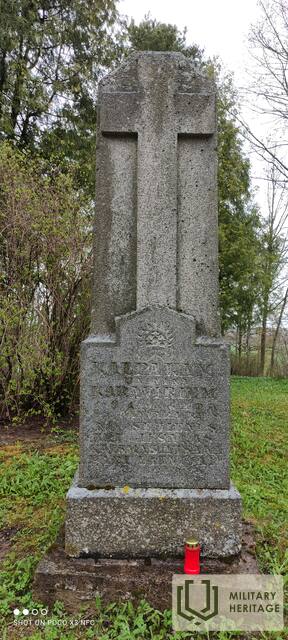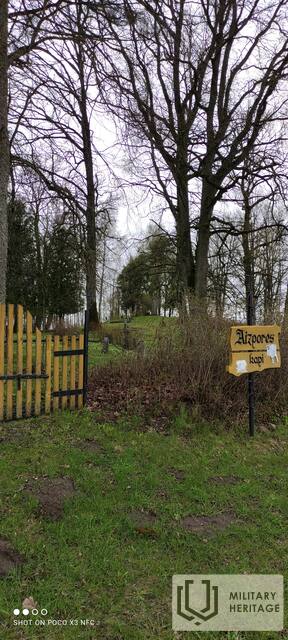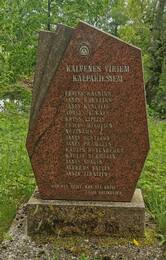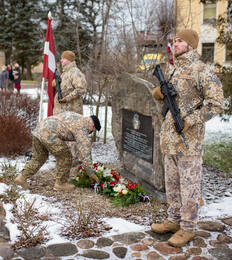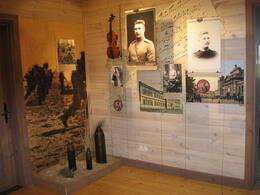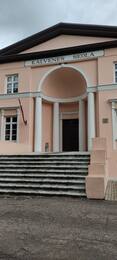Aizporu half manor in the War of Independence
Aizporu Half Manor, Aizpute district, Kalvene municipality, is the westernmost place in Latvia to which Colonel Oskars Kalpaks' separate battalion retreated.
Halfway between Rudbārži and Kalvenė, on the side of the road, is the Aizpore cemetery. There is a monument and 12 memorials to the volunteer soldiers of Oskars Kalpaka's battalion.
In January 1919, after leaving Jelgava via Lielauce, where the first battle was fought in the War of Independence, the battalion of Colonel Oskars Kalpaks, after forcing Venta, arrived at the Lēne and Rudbārži manors. In the early morning of January 22, the battalion of Colonel O. Kalpaks took up defensive positions at the intersection of Liepāja - Jelgava highway and Embūte - Valtaiķi road in the AIZPORU half-manor area. To the left was the Baltic Landeswehr, to the right was the German Iron Division. As the further attack of the Soviet Latvian forces from Skrunda did not follow, the O. Kalpaks battalion returned to its previous positions at the RUDBĀRŽI manor.
In 1922, the former men of the Kalpaka Battalion erected a temporary memorial sign - an oak block with a copper plate.
In the 1930s, the O. Kalpaks Society commissioned a monument to the sculptor Jānis BRIEDIS “Beginning”, as well as the idea of a large memorial complex with an oak tree - Varoņi Alley to Rudbārži Manor - is being promoted and accepted by the President of Latvia. The sculptor Kārlis JANSONS acquires the right to sell the memorial place.
Due to the fact that the main financiers of the production of the monument are Student Corporations, the monument to J. Briežs built on May 15, 1939 is erected in Pinki (the restored monument is located in Pinki) in honor of the Student Company belonging to the O. Kalpaks Battalion.
In 1940, with the occupation of Latvia, the plans to sell the memorial site came to a halt. According to unofficial information, the planned Heroes' Alley has been partially realized by planting oaks from Rudbārži manor in the direction of Aizporai and is now visible near the Liepāja highway.
A modern memorial place
After the restoration of the independence of the Republic of Latvia on May 15, 1993, a memorial sign - the Ray of Light - was unveiled. The 2.3 m high memorial sign carved in gray granite is made by sculptors Harijs SPRINCIS and Imants LUKAŽIS (1930 - 2007, buried in Aizporu Cemetery), whose father is also a soldier of the O. Kalpaks Battalion. The words of the poet Ed.VIRZAS are engraved on the memorial sign:
KALPAKAM
AND HIS
FOR SOLDIERS
1919. YEAR
MORNING, JANUARY 25
FROM HERE
ALSO GET STARTED
WEAVING WEIGHT
OVER LATVIA






Source: Lismanis, J. 1915-1920. In memory of battles and fallen soldiers: memorial sites of the First World War and the Latvian Liberation Fight. Riga: NIMS, 1999. p.
Related timeline
Related topics
Related objects
Monument and memorial markers to the soldiers of O. Kalpaka Battalion at Aizpore Cemetery
About halfway between Rudbārži and Kalvė, on the side of an old road parallel to the A9 highway, is the Aizpore Cemetery.
There is a monument and 12 memorials to the volunteer soldiers of Oskars Kalpaka's battalion, who lived in the surrounding houses.
...Battle of Skrunda Memorial and Flag Day
The Skrunda Battle Memorial is located in the centre of Skrunda, in Oskaras Kalpaka Park near the Skrunda Culture House, at the intersection of Kuldīgas and Liepājas Streets. In 2005, a stone was erected at the memorial commemorating the battle of 29 January 1919, when the battalion commanded by Oskars Kalpaks, together with the German and Russian units of the Landeswehr, liberated Skrunda from the Bolsheviks. The tradition of Flag Day has been maintained since 2004, commemorating the first town liberated from the Bolsheviks and its liberators, who raised the Latvian flag at the Skrunda church on 29 January 1919.
...Oskars Kalpaks Museum and Memorial Site “Airītes”
The Oskars Kalpaks Museum and Memorial Site Airītes is located between Saldus and Skrunda near the A9 highway. The exhibit has extensive information about Colonel Oskars Kalpaks and his battalion, and shows the history of the Latvian National Army and the memorial site Airītes. The exhibit reveals Colonel Oskars Kalpaks as a personality, as a soldier and as a fighter for Latvia's independence. Audio logs in Latvian, English and German are also available as part of the exhibit. They emphasize the importance of the historic events of 1918/1919 in the protecting the statehood of Latvia. The museum building has been restored.
...Tāšu - Padure Manor
The Tasi - Padure Manor Castle is now known as Kalvene Primary School, founded in 1922. The school building was built in the 19th century in the late classical style as a hunting lodge for Count Keizerling.
At the beginning of 1919, the first mobilised men who answered the call for mobilisation gathered here and came to the manor. On 22 January 1919, the Latvian Separate Cavalry Unit was...
Steles in memory of the knights of the War Orders of Lāčplēš
Twenty-seven knights of the Lāčplēš Military Order are associated with the Aizpute region.
Commemorative stelae of a uniform pattern were erected throughout Latvia in honor of the soldiers who fell in the Latvian Freedom Struggle, in which the text engraving font corresponds to the standard of the heroes' memorial plaques, which is analogous to the engraving of the sandstone memorials of the Riga Brothers' Grave and Central Graveyard...




